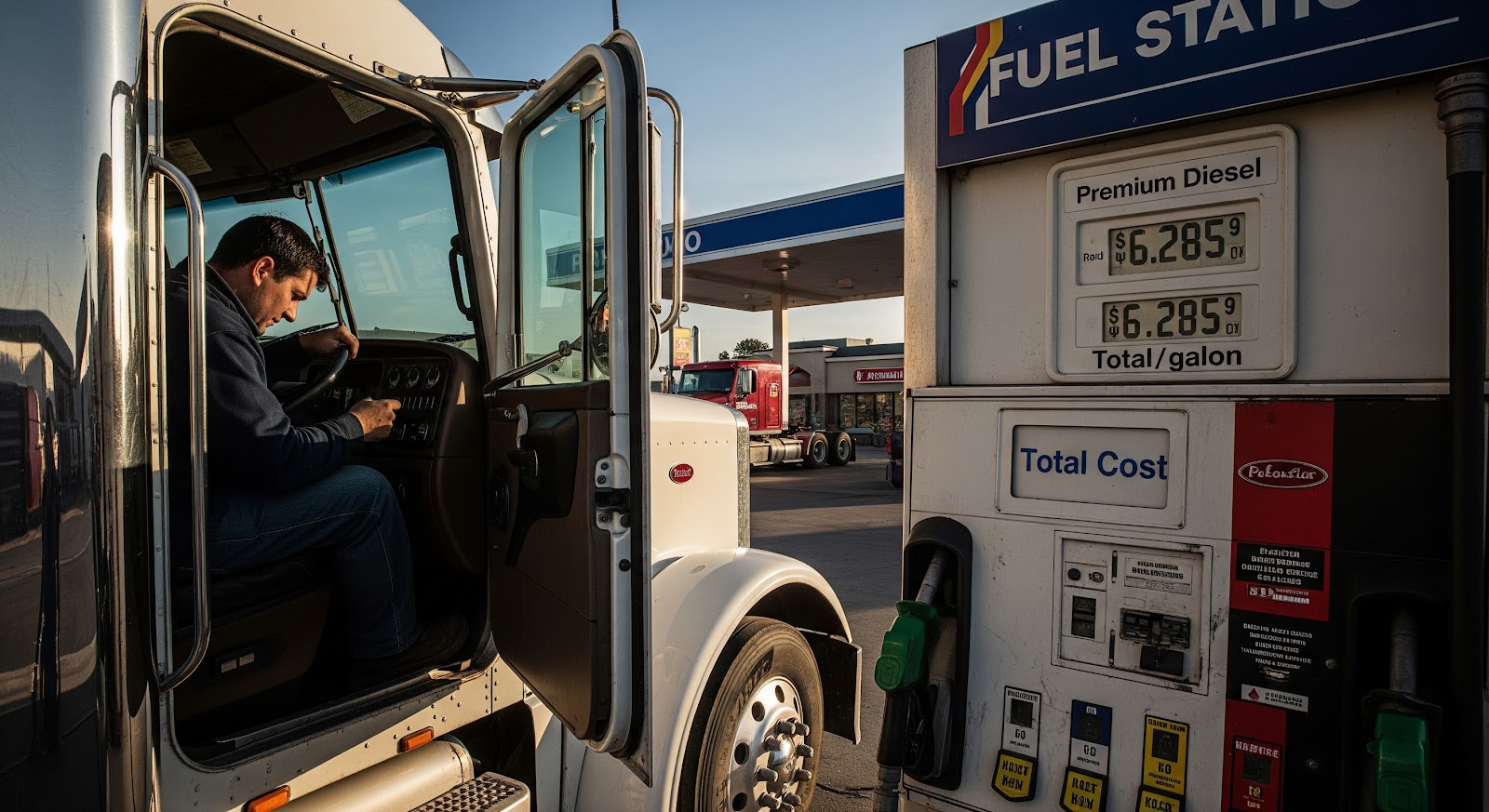Fuel costs have always been a critical variable in the transportation and logistics industry, but in recent months, the pressure has intensified. National averages for diesel and gasoline continue to climb, leaving many fleet operators and independent truckers scrambling to adapt. Several factors including global oil supply disruptions, inflationary pressures, and seasonal demand shifts have combined to drive fuel costs higher than anticipated.
For an industry that relies on thousands of gallons of fuel per week, even a modest price increase can have a substantial impact on operating margins. Every cent added at the pump is magnified across large fleets, while owner-operators often bear the brunt of these changes directly. As fuel prices are rising across the U.S., trucking operations are feeling the pressure like never before.
Whether it’s route planning, load management, or rate negotiations, rising fuel costs are forcing companies to rethink how they operate. In the following sections, we’ll examine what’s behind these increasing prices, how they’re impacting the trucking sector, and what fleets can do to mitigate the effects.
What’s Causing Fuel Prices to Rise?
Understanding the root causes of rising gasoline prices is essential for trucking companies looking to anticipate and adapt to ongoing fuel cost challenges. Several key factors are driving the current surge in prices, and each one contributes to the growing strain on transportation budgets nationwide.
Geopolitical Tensions and Global Oil Supply
One of the most influential factors behind increasing fuel prices is geopolitical instability, particularly in oil-producing regions. Conflicts in the Middle East, trade restrictions, and production cuts by OPEC+ members can all tighten global oil supply, driving crude oil prices higher. When crude prices spike, fuel prices at the pump tend to follow quickly.
In particular, recent production adjustments and ongoing sanctions on key oil exporters have reduced market stability, increasing the volatility of both gasoline and diesel markets. This global uncertainty is passed directly onto U.S. trucking companies in the form of higher costs per gallon.
Supply Chain Disruptions and Refinery Limitations
Beyond geopolitical issues, domestic supply chain disruptions also play a critical role. Refineries across the U.S. have faced unplanned maintenance outages, labor shortages, and hurricane-related shutdowns, limiting fuel output just as demand has rebounded.
The refining sector’s inability to ramp up production quickly enough has created regional shortages, particularly in high-traffic freight corridors. This supply-demand imbalance is one of the main reasons fuel prices are rising so sharply across the country, especially in states with fewer local refining resources.
Seasonal Demand and Market Speculation
Seasonal demand shifts also impact fuel pricing. In the summer months, consumer travel increases, putting more strain on fuel supplies. The trucking industry must then compete with rising consumer demand, which drives prices even higher.
Additionally, futures markets and investor speculation can cause short-term spikes in fuel prices. Traders reacting to global events, policy announcements, or anticipated shortages can create price swings, even before any real supply changes occur.
Visualizing the Impact: Daily Gas Prices Chart
To better understand the trend, a daily gas prices chart from sources like AAA or the U.S. Energy Information Administration (EIA) can be helpful. These charts highlight how dramatically prices have climbed over recent months and offer insight into regional disparities.
For example, in many states, diesel has increased by more than $1.00 per gallon year-over-year. These visual tools help paint a clear picture of just how fast and far increased fuel prices have escalated, underscoring the urgency for trucking operations to find cost-saving strategies.
Direct Impact on Trucking Operations
As increased fuel prices become the new normal, trucking companies are experiencing immediate and measurable consequences across all levels of operation. From rising daily expenses to disrupted delivery schedules, the effects are being felt industry-wide but especially among small operators who lack the financial cushion to absorb sudden cost hikes.
Operational Costs Are Soaring
Fuel is typically the largest single variable cost in a trucking operation. When prices at the pump rise, so do overall operating expenses. For a fleet logging thousands of miles each week, even a small price bump translates into tens of thousands of dollars annually.
These elevated fuel costs cut directly into profit margins, leaving less room for investment in equipment, driver pay, or technology. While some fleets attempt to pass these costs on to customers through fuel surcharges, not all contracts allow for such adjustments especially for smaller carriers working with tight budgets and fixed-rate agreements.
The compounding effect of increased fuel prices is forcing fleet managers to constantly reevaluate spending, from dispatching practices to vehicle maintenance schedules, in an attempt to regain control over operating budgets.
Smaller Fleets and Owner-Operators Under Pressure
Independent owner-operators and small trucking companies are often the hardest hit when fuel prices surge. Unlike large carriers that may benefit from bulk fuel purchasing agreements or fuel hedging strategies, smaller operators pay retail prices at the pump and they feel every penny of the increase.
Without significant reserves or negotiating leverage, many of these drivers face the difficult choice of reducing their operating range, postponing trips, or even parking their trucks altogether until fuel prices stabilize. For some, high fuel costs could mean the difference between staying in business and shutting down.
The volatility in fuel pricing also creates uncertainty in planning and forecasting. As fuel prices are rising, it’s increasingly difficult for small fleets to budget accurately or price their services competitively without taking a financial hit.
Route Adjustments and Delivery Delays
Another consequence of increased fuel prices is the need to alter routes to maximize efficiency and reduce miles driven. Carriers are now relying more heavily on route optimization tools, real-time traffic data, and fuel stop planning apps to minimize fuel consumption.
In some cases, freight that was once profitable to haul no longer makes financial sense due to the high fuel cost involved. This has led to a reevaluation of lanes and regional preferences, with carriers favoring routes with better fueling options or more efficient stop clusters.
Unfortunately, these changes can also lead to longer transit times, limited availability of trucks in certain areas, and ultimately, delivery delays. The ripple effect is felt not just by carriers, but also by shippers and end consumers waiting on goods.
How Fleets Are Responding to Rising Fuel Prices
With rising fuel prices cutting deeply into profit margins, many fleets are taking proactive steps to minimize the financial impact. Whether through technology adoption, operational strategy, or improved contract management, successful carriers are finding ways to stay competitive despite ongoing fuel cost volatility.
Smarter Route Planning and Fuel-Efficient Driving
One of the first areas of focus for many fleets is improving route efficiency to cut down on unnecessary fuel usage. By leveraging GPS-based route optimization software and telematics systems, carriers can reduce idling time, avoid high-traffic areas, and minimize empty miles.
In addition to smarter routing, training drivers in fuel-efficient driving practices is proving effective. Many fleets are now implementing programs that emphasize:
- Smooth acceleration and braking
- Reduced idling
- Maintaining consistent speeds
- Using cruise control where appropriate
- Proper tire inflation and maintenance
Together, these changes not only reduce fuel consumption but also extend vehicle lifespan, offering savings beyond the pump.
Investing in Fuel-Saving Technology
Facing sustained increases in fuel prices, forward-thinking carriers are turning to new technology to improve fuel economy across their fleet. Some of the most popular investments include:
- Aerodynamic upgrades: Trailer skirts, cab fairings, and boat tails that reduce drag
- Auxiliary power units (APUs): To power in-cab electronics without running the engine
- Low rolling resistance tires: Designed to reduce friction and improve MPG
- Electric or hybrid vehicles: Especially for local or short-haul routes
Although these upgrades can involve upfront costs, they often pay for themselves through long-term fuel savings especially when fuel prices are rising month after month.
Fuel Surcharge Agreements and Flexible Contracts
As increased fuel prices become a recurring challenge, more fleets are working to secure contracts that include flexible fuel surcharge agreements. These clauses allow carriers to adjust rates in accordance with real-time fuel market fluctuations, offering a buffer against unpredictable expenses.
To manage this effectively, many carriers tie surcharge calculations to public indices such as:
- The U.S. Energy Information Administration (EIA) weekly diesel prices
- Regional benchmarks based on route geography
Having these protections in place not only shields carriers from sudden price hikes but also strengthens trust and transparency with shippers who increasingly expect dynamic, data-backed pricing.
Industry Outlook: Will Fuel Prices Continue to Climb?
As trucking companies work to adapt to current conditions, many are asking the same question: will fuel prices stabilize or continue to rise? Understanding what lies ahead is crucial for both short-term planning and long-term strategy.
Expert Predictions and Economic Indicators
Economists and energy analysts remain cautiously pessimistic about fuel price trends. Several forecasts from institutions like the U.S. Energy Information Administration (EIA) and industry think tanks suggest that prices may remain elevated through the end of the fiscal year, particularly for diesel.
Key drivers influencing this outlook include:
- Global oil supply limitations due to ongoing conflicts and production caps.
- Post-pandemic recovery in industrial output and freight demand.
- Persistent inflation driving up transportation and refinery input costs.
- Currency fluctuations, especially a weakening U.S. dollar, making oil imports more expensive.
These factors indicate that rising fuel prices may not be temporary. Instead, experts warn that we could be looking at a “new normal” where fuel remains a significant cost pressure well into the next fiscal year.
Seasonal Trends and Fuel Price Volatility
Fuel prices often follow seasonal trends, peaking in the summer and dipping slightly during winter months. However, recent years have shown that seasonal patterns are becoming less predictable due to global instability and climate-related disruptions.
Typical seasonal trends that may affect pricing include:
- Summer travel season increases gasoline demand, which can also drive up diesel costs.
- Winter storms and refinery outages, which disrupt fuel production and distribution.
- Harvest seasons, especially in agricultural regions, increase fuel demand for shipping.
While some relief may come in colder months, it’s likely to be temporary. Long-term pricing trends are still upward, with most indicators suggesting increased fuel prices will continue well into next year.
Monitoring Trends: Using Daily Gas Prices Charts
For fleet operators and logistics planners, staying informed is critical. One of the most reliable ways to track current and projected fuel costs is through a daily gas prices chart. Trusted sources include:
These charts allow businesses to monitor price movements regionally and nationally, helping them plan routes, manage budgets, and adjust fuel surcharge calculations with real-time data.
When fuel prices are rising, these tools can serve as early warning systems enabling proactive adjustments before costs spiral out of control.
Navigating the Road Ahead
There’s no doubt that fuel prices are rising and the ripple effects are being felt across every level of the trucking industry. From operational costs and freight pricing to driver satisfaction and supply chain relationships, the impact of elevated fuel costs continues to challenge fleets of all sizes.
As these trends persist, trucking companies must stay agile and informed. Adopting smarter routing, investing in fuel-saving technology, and negotiating flexible contracts are no longer optional; they’re essential for protecting margins and staying competitive.
Most importantly, compliance and operational efficiency must remain a top priority. Every dollar saved and every mile optimized counts in today’s high-cost environment.As trucking businesses navigate increasing fuel prices, staying efficient and compliant is more important than ever. ExpressTruckTax offers trusted, IRS-authorized tools to help you stay on track whether it’s filing Form 2290, claiming tax credits, or managing your fleet’s compliance.



